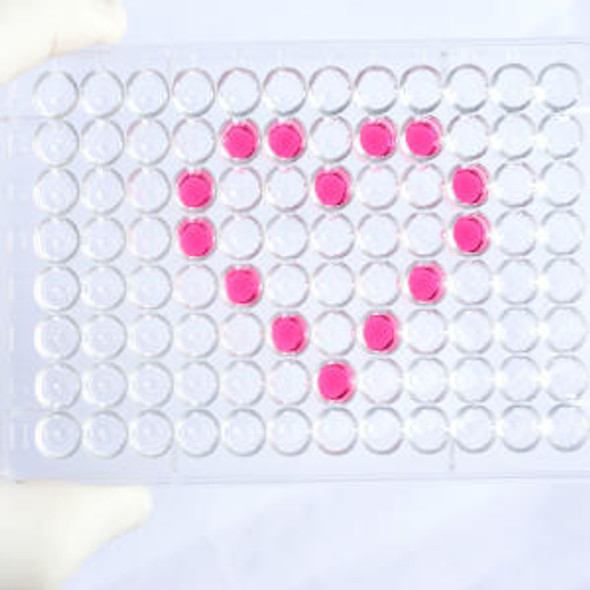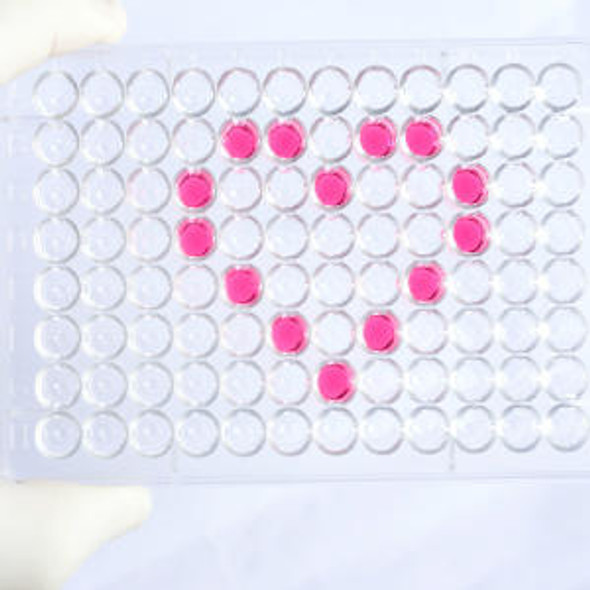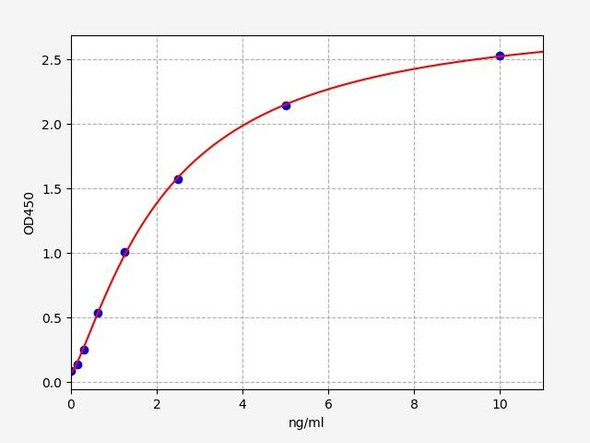Human STK3 (Serine/threonine-protein kinase 3) ELISA Kit (HUFI06291)
- SKU:
- HUFI06291
- Product Type:
- ELISA Kit
- Size:
- 96 Assays
- Uniprot:
- Q13188
- Sensitivity:
- 0.094ng/ml
- Range:
- 0.156-10ng/ml
- ELISA Type:
- Sandwich
- Synonyms:
- STK3, Serine/threonine-protein kinase 3, Mammalian STE20-like protein kinase 2, MST-2, STE20-like kinase MST2, Serine/threonine-protein kinase Krs-1, MST2/N, MST2/C, KRS1, MST2
- Reactivity:
- Human
Description
Human STK3 (Serine/threonine-protein kinase 3) ELISA
STK3 (Serine/Threonine Kinase 3) STK3 codes for a serine/threonine protein kinase that is activated by proapoptotic molecules and thus functions as a growth suppressor. STK is a protein kinase that is expressed in many tissues and organs. The highest levels of STK are found in the brain, heart, liver, and pancreas. STK plays important roles in cellular signaling pathways and has been implicated in the development of cancer, diabetes, and other diseases. Diseases associated with STK3 include Non-Syndromic X-Linked Intellectual Disability.
| Product Name: | Human STK3 (Serine/threonine-protein kinase 3) ELISA Kit |
| Product Code: | HUFI06291 |
| Size: | 96 Assays |
| Alias: | STK3 ELISA Kit, Serine/threonine-protein kinase 3 ELISA Kit, Mammalian STE20-like protein kinase 2 ELISA Kit, MST-2 ELISA Kit, STE20-like kinase MST2 ELISA Kit, Serine/threonine-protein kinase Krs-1 ELISA Kit, MST2/N ELISA Kit, MST2/C ELISA Kit, KRS1 ELISA Kit, MST2 ELISA Kit |
| Detection method: | Sandwich ELISA, Double Antibody |
| Application: | This immunoassay kit allows for the in vitro quantitative determination of Human STK3 (Serine/threonine-protein kinase 3) concentrations in serum plasma and other biological fluids. |
| Sensitivity: | < 0.094ng/ml |
| Range: | 0.156-10ng/ml |
| Storage: | 4°C for 6 months |
| Note: | For Research Use Only |
| Recovery: | Matrices listed below were spiked with certain level of Human STK3 (Serine/threonine-protein kinase 3) and the recovery rates were calculated by comparing the measured value to the expected amount of Human STK3 (Serine/threonine-protein kinase 3) in samples. | ||||||||||||||||
| |||||||||||||||||
| Linearity: | The linearity of the kit was assayed by testing samples spiked with appropriate concentration of Human STK3 (Serine/threonine-protein kinase 3) and their serial dilutions. The results were demonstrated by the percentage of calculated concentration to the expected. | ||||||||||||||||
| |||||||||||||||||
| CV(%): | Intra-Assay: CV<8% Inter-Assay: CV<10% |
| Component | Quantity | Storage |
| ELISA Microplate (Dismountable) | 8×12 strips | 4°C for 6 months |
| Lyophilized Standard | 2 | 4°C/-20°C |
| Sample/Standard Dilution Buffer | 20ml | 4°C |
| Biotin-labeled Antibody(Concentrated) | 120ul | 4°C (Protect from light) |
| Antibody Dilution Buffer | 10ml | 4°C |
| HRP-Streptavidin Conjugate(SABC) | 120ul | 4°C (Protect from light) |
| SABC Dilution Buffer | 10ml | 4°C |
| TMB Substrate | 10ml | 4°C (Protect from light) |
| Stop Solution | 10ml | 4°C |
| Wash Buffer(25X) | 30ml | 4°C |
| Plate Sealer | 5 | - |
Other materials and equipment required:
- Microplate reader with 450 nm wavelength filter
- Multichannel Pipette, Pipette, microcentrifuge tubes and disposable pipette tips
- Incubator
- Deionized or distilled water
- Absorbent paper
- Buffer resevoir
| UniProt Protein Function: | MST2: a protein kinase of the STE20 family. Activated by apoptotic signals as well as other stress conditions. Full activation requires both phosphorylation and caspase-mediated cleavage. Following cleavage by caspase-3, undergoes irreversible autophosphorylation. Full-length is mainly unphosphorylated in the rat thymus and cultured cells, whereas caspase-3-cleaved MST2 in apoptotic cells is highly phosphorylated. |
| UniProt Protein Details: | Protein type:Protein kinase, STE; Protein kinase, Ser/Thr (non-receptor); Kinase, protein; Autophagy; EC 2.7.11.1; STE group; STE20 family; MST subfamily Chromosomal Location of Human Ortholog: 8q22.2 Cellular Component: cytoplasm; cytosol; nucleus Molecular Function:protein dimerization activity; protein serine/threonine kinase activity; protein serine/threonine kinase activator activity; protein binding; magnesium ion binding; ATP binding; receptor signaling protein serine/threonine kinase activity; protein kinase activity Biological Process: central nervous system development; positive regulation of protein binding; protein stabilization; positive regulation of apoptosis; apoptosis; positive regulation of JNK cascade; signal transduction; negative regulation of organ growth; protein amino acid phosphorylation; negative regulation of cell proliferation; positive regulation of protein kinase B signaling cascade; positive regulation of fat cell differentiation; positive regulation of transcription factor activity; neural tube formation |
| NCBI Summary: | This gene encodes a serine/threonine protein kinase activated by proapoptotic molecules indicating the encoded protein functions as a growth suppressor. Cleavage of the protein product by caspase removes the inhibitory C-terminal portion. The N-terminal portion is transported to the nucleus where it homodimerizes to form the active kinase which promotes the condensation of chromatin during apoptosis. Multiple transcript variants encoding different isoforms have been found for this gene. [provided by RefSeq, Jan 2012] |
| UniProt Code: | Q13188 |
| NCBI GenInfo Identifier: | 46577700 |
| NCBI Gene ID: | 6788 |
| NCBI Accession: | Q13188.2 |
| UniProt Secondary Accession: | Q13188,Q15445, Q15801, Q96FM6, A8K722, B3KYA7, |
| UniProt Related Accession: | Q13188 |
| Molecular Weight: | 491 |
| NCBI Full Name: | Serine/threonine-protein kinase 3 |
| NCBI Synonym Full Names: | serine/threonine kinase 3 |
| NCBI Official Symbol: | STK3 |
| NCBI Official Synonym Symbols: | KRS1; MST2 |
| NCBI Protein Information: | serine/threonine-protein kinase 3; MST-2; STE20-like kinase MST2; mammalian STE20-like protein kinase 2; serine/threonine-protein kinase Krs-1; serine/threonine kinase 3 (STE20 homolog, yeast); serine/threonine kinase 3 (Ste20, yeast homolog) |
| UniProt Protein Name: | Serine/threonine-protein kinase 3 |
| UniProt Synonym Protein Names: | Mammalian STE20-like protein kinase 2; MST-2; STE20-like kinase MST2; Serine/threonine-protein kinase Krs-1Cleaved into the following 2 chains:Serine/threonine-protein kinase 3 36kDa subunit; MST2/N; Serine/threonine-protein kinase 3 20kDa subunit; MST2/C |
| Protein Family: | Serine/threonine-protein kinase |
| UniProt Gene Name: | STK3 |
| UniProt Entry Name: | STK3_HUMAN |
*Note: Protocols are specific to each batch/lot. For the correct instructions please follow the protocol included in your kit.
Before adding to wells, equilibrate the SABC working solution and TMB substrate for at least 30 min at 37 °C. When diluting samples and reagents, they must be mixed completely and evenly. It is recommended to plot a standard curve for each test.
| Step | Protocol |
| 1. | Set standard, test sample and control (zero) wells on the pre-coated plate respectively, and then, record their positions. It is recommended to measure each standard and sample in duplicate. Wash plate 2 times before adding standard, sample and control (zero) wells! |
| 2. | Aliquot 0.1ml standard solutions into the standard wells. |
| 3. | Add 0.1 ml of Sample / Standard dilution buffer into the control (zero) well. |
| 4. | Add 0.1 ml of properly diluted sample ( Human serum, plasma, tissue homogenates and other biological fluids.) into test sample wells. |
| 5. | Seal the plate with a cover and incubate at 37 °C for 90 min. |
| 6. | Remove the cover and discard the plate content, clap the plate on the absorbent filter papers or other absorbent material. Do NOT let the wells completely dry at any time. Wash plate X2. |
| 7. | Add 0.1 ml of Biotin- detection antibody working solution into the above wells (standard, test sample & zero wells). Add the solution at the bottom of each well without touching the side wall. |
| 8. | Seal the plate with a cover and incubate at 37 °C for 60 min. |
| 9. | Remove the cover, and wash plate 3 times with Wash buffer. Let wash buffer rest in wells for 1 min between each wash. |
| 10. | Add 0.1 ml of SABC working solution into each well, cover the plate and incubate at 37 °C for 30 min. |
| 11. | Remove the cover and wash plate 5 times with Wash buffer, and each time let the wash buffer stay in the wells for 1-2 min. |
| 12. | Add 90 µL of TMB substrate into each well, cover the plate and incubate at 37 °C in dark within 10-20 min. (Note: This incubation time is for reference use only, the optimal time should be determined by end user.) And the shades of blue can be seen in the first 3-4 wells (with most concentrated standard solutions), the other wells show no obvious color. |
| 13. | Add 50 µL of Stop solution into each well and mix thoroughly. The color changes into yellow immediately. |
| 14. | Read the O.D. absorbance at 450 nm in a microplate reader immediately after adding the stop solution. |
When carrying out an ELISA assay it is important to prepare your samples in order to achieve the best possible results. Below we have a list of procedures for the preparation of samples for different sample types.
| Sample Type | Protocol |
| Serum | If using serum separator tubes, allow samples to clot for 30 minutes at room temperature. Centrifuge for 10 minutes at 1,000x g. Collect the serum fraction and assay promptly or aliquot and store the samples at -80°C. Avoid multiple freeze-thaw cycles. If serum separator tubes are not being used, allow samples to clot overnight at 2-8°C. Centrifuge for 10 minutes at 1,000x g. Remove serum and assay promptly or aliquot and store the samples at -80°C. Avoid multiple freeze-thaw cycles. |
| Plasma | Collect plasma using EDTA or heparin as an anticoagulant. Centrifuge samples at 4°C for 15 mins at 1000 × g within 30 mins of collection. Collect the plasma fraction and assay promptly or aliquot and store the samples at -80°C. Avoid multiple freeze-thaw cycles. Note: Over haemolysed samples are not suitable for use with this kit. |
| Urine & Cerebrospinal Fluid | Collect the urine (mid-stream) in a sterile container, centrifuge for 20 mins at 2000-3000 rpm. Remove supernatant and assay immediately. If any precipitation is detected, repeat the centrifugation step. A similar protocol can be used for cerebrospinal fluid. |
| Cell culture supernatant | Collect the cell culture media by pipette, followed by centrifugation at 4°C for 20 mins at 1500 rpm. Collect the clear supernatant and assay immediately. |
| Cell lysates | Solubilize cells in lysis buffer and allow to sit on ice for 30 minutes. Centrifuge tubes at 14,000 x g for 5 minutes to remove insoluble material. Aliquot the supernatant into a new tube and discard the remaining whole cell extract. Quantify total protein concentration using a total protein assay. Assay immediately or aliquot and store at ≤ -20 °C. |
| Tissue homogenates | The preparation of tissue homogenates will vary depending upon tissue type. Rinse tissue with 1X PBS to remove excess blood & homogenize in 20ml of 1X PBS (including protease inhibitors) and store overnight at ≤ -20°C. Two freeze-thaw cycles are required to break the cell membranes. To further disrupt the cell membranes you can sonicate the samples. Centrifuge homogenates for 5 mins at 5000xg. Remove the supernatant and assay immediately or aliquot and store at -20°C or -80°C. |
| Tissue lysates | Rinse tissue with PBS, cut into 1-2 mm pieces, and homogenize with a tissue homogenizer in PBS. Add an equal volume of RIPA buffer containing protease inhibitors and lyse tissues at room temperature for 30 minutes with gentle agitation. Centrifuge to remove debris. Quantify total protein concentration using a total protein assay. Assay immediately or aliquot and store at ≤ -20 °C. |
| Breast Milk | Collect milk samples and centrifuge at 10,000 x g for 60 min at 4°C. Aliquot the supernatant and assay. For long term use, store samples at -80°C. Minimize freeze/thaw cycles. |
Fill out our quote form below and a dedicated member of staff will get back to you within one working day!






